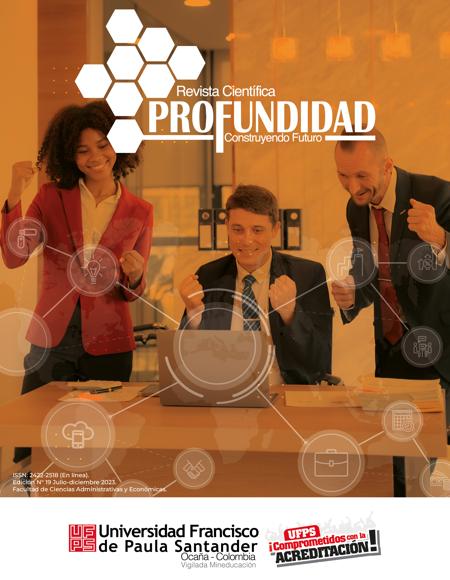Neuroeconomía y Decisiones Estratégicas: El Impacto en las Finanzas Sostenibilidad de Empresas Multinacionales
Neuro-economics and Strategic Decisions: The Impact on Financial Sustainability of Multinational Enterprises
Contenido principal del artículo
Más que nunca, involucrar un enfoque multidisciplinario en la toma de decisiones muestra un arsenal de capacidad necesario para el éxito en las preocupaciones gerenciales en todos los sectores de la economía. La psicología y la economía que capturan los comportamientos humanos forman parte de esta investigación interdisciplinaria que abarca años, aunque muchos están lejos de esta realidad.
El documento muestra el impacto de la neuroeconomía en las decisiones financieras estratégicas en las empresas multinacionales, implementando teorías de decisiones, utilidad y expectativas en las empresas multinacionales
de la industria de los medios en Nigeria, al mismo tiempo que aborda los efectos de las emociones que afectan los resultados publicitarios y la marca, y las decisiones financieras que construyen el marco teórico a partir de recursos de los motores de búsqueda Google Scholar y Scopus. Utilizando cinco multinacionales como muestra en una población de 15 empresas de medios registradas en Nigeria, el estudio utiliza la metodología de la teoría fundamentada y discusiones de grupos focales para descubrir la realidad de la influencia emocional en las decisiones estratégicas y el análisis de regresión múltiple para probar la significación estadística de las variables independientes. en la variable dependiente. El resultado muestra que la neuroeconomía contribuye significativamente a la toma de decisiones económicas en todos los sectores, incluida la industria de los medios. Aunque la generalización de la investigación es un desafío debido a las variaciones económicas en los diferentes mercados, el informe publica información útil para la formulación de políticas, la productividad y la creación de riqueza.
Descargas
Detalles del artículo
Allen, D. (1977). A Review of Process Theories of Decision Making. Sage Journals. https://doi.org/10.1177/135050767700800204. DOI: https://doi.org/10.1177/135050767700800204
Bashir, S., Mir, A., Altwaijri, N., Uzair, M., Khalil, A., Besher, R., ... & Abualait, T. (2023). Neuroeconomics of decision-making during COVID-19 pandemic. Heliyon. 9. https://doi.org/10.1016/j.heliyon.2023.e13252. DOI: https://doi.org/10.1016/j.heliyon.2023.e13252
Bossaerts, P., & Murawski, C. (2015). From behavioural economics to neuroeconomics to decision neuroscience: the ascent of biology in research on human decision making. Current Opinion in Behavioral Sciences, 5, 37- 42. DOI: https://doi.org/10.1016/j.cobeha.2015.07.001
Collins, J. M. (2012). Financial advice: a substitute for financial literacy? Finance Service. 21, 307–322. https://10.2139/ssrn.2046227. DOI: https://doi.org/10.2139/ssrn.2046227
Doyle, G. (2002). Understanding Media Economics. Mass Communication, Media Policy & Regulation, Cultural Studies. Sage Publications Limited. http://dx.doi.org/10.4135/9781446279960. DOI: https://doi.org/10.4135/9781446279960
Frees, E. (2004). Longitudinal and panel data: Analysis and applications in the social sciences. New York, USA: Cambridge University Press. DOI: https://doi.org/10.1017/CBO9780511790928
Friedman, M., & Savage, L. J. (1948). The utility analysis of choices involving risk. Journal of political Economy, 56(4), 279-304. DOI: https://doi.org/10.1086/256692
Gerlach, P. (2017). The Games Economists Play: Why Economics Students Behave More Selfishly than Other Students. PLoS One 12: e0183814. https://10.1371/ journalpone.0183814 DOI: https://doi.org/10.1371/journal.pone.0183814
Glimcher, P. W., & Rustichini, A. (2004). Neuroeconomics: the consilience of brain and decision. Science, 306(5695), 447- 452. DOI: https://doi.org/10.1126/science.1102566
Harlen, C. M. (1999). A reappraisal of classical economic nationalism and economic liberalism. International Studies Quarterly, 43(4), 733-744. https://doi.org/10.1111/0020-8833.00143. DOI: https://doi.org/10.1111/0020-8833.00143
Haselhuhn, M. P., Pope, D. G., Schweitzer, M. E., & Fishman, P. (2012). The impact of personal experience on behavior: Evidence from video-rental fines. Management Science, 58(1), 52-61. DOI: https://doi.org/10.1287/mnsc.1110.1367
Henderson, H. V., & Velleman, P. F. (1981). Building multiple regression models interactively. Biometrics, 391- 411. https://doi.org/10.2307/2530428. DOI: https://doi.org/10.2307/2530428
Kelley, K., & Bolin, J. H. (2013). Multiple regression. In Handbook of quantitative methods for educational research (pp. 69-101). Brill. DOI: https://doi.org/10.1007/978-94-6209-404-8_4
Khan, S. N. (2014). Qualitative research method: Grounded theory. International journal of business and management, 9(11), 224-233. DOI: https://doi.org/10.5539/ijbm.v9n11p224
Kumar, S., Gorodnichenko, Y., & Coibion, O. (2022). The effect of macroeconomic uncertainty on firm decisions (No. w30288). National Bureau of Economic Research. DOI 10.3386/w30288. DOI: https://doi.org/10.3386/w30288
Meyer, K. E., Van Witteloostuijn, A., & Beugelsdijk, S. (2017). What’s in ap? Reassessing best practices for conducting and reporting hypothesis-testing research. Journal of International Business Studies, 48, 535-551. DOI: https://doi.org/10.1057/s41267-017-0078-8
Pekrun, R. (2011). Emotions as drivers of learning and cognitive development. New perspectives on affect and learning technologies, 23-39. DOI: https://doi.org/10.1007/978-1-4419-9625-1_3
Petracca, E. (2020). Neuroeconomics beyond the brain: some externalist notions of choice. Journal of Economic Methodology, 27(4), 275-291. https://doi.org/10.1080/1350178X.2020.1789690. DOI: https://doi.org/10.1080/1350178X.2020.1789690
Phelps, E. A. (2009). The study of emotion in neuroeconomics. In Neuroeconomics (pp. 233-250). Academic Press. https://doi.org/10.1016/B978-0-12-374176-9.00016-6. DOI: https://doi.org/10.1016/B978-0-12-374176-9.00016-6
Platt, M. L., & Huettel, S. A. (2008). Risky business: the neuroeconomics of decision making under uncertainty. Nature neuroscience, 11(4), 398-403. DOI: https://doi.org/10.1038/nn2062
Promberger, M., & Marteau, T. M. (2013). When do financial incentives reduce intrinsic motivation? comparing behaviors studied in psychological and economic literatures. Health Psychology, 32(9), 950. DOI: https://doi.org/10.1037/a0032727
Robertson, L. T. (2002). Memory and the brain. Journal of Dental Education, 66(1), 30-42. DOI: https://doi.org/10.1002/j.0022-0337.2002.66.1.tb03506.x
Rostomyan, A. (2015). The impact of emotions on decision making process in the field of Neuroeconomics. Journal of Business and Economics, 6(7), 1268-1276. DOI: 10.15341/jbe(2155-7950)/07.06.2015/003. DOI: https://doi.org/10.15341/jbe(2155-7950)/07.06.2015/003
Sanfey, A. (2007). Social Decision-Making: Insights from Game Theory and Neuroscience. Science. 318. Received from: https://www.sciencemag.org/ DOI: https://doi.org/10.1126/science.1142996
Sanfey, A. G., Loewenstein, G., McClure, S. M., & Cohen, J. D. (2006). Neuroeconomics: cross-currents in research on decision-making. Trends in cognitive sciences, 10(3), 108-116. DOI: https://doi.org/10.1016/j.tics.2006.01.009
Sargent, T. (2021). Rational Expectation. The Library of Economics and Liberty. Received from: https://www.econlib.org/library/Enc/RationalExpectations.html.
Shi, G., & Wang, Q. (2019). The application of utility theory in the making-decision of marketing risk management. In International Academic Conference on Frontiers in Social DOI: https://doi.org/10.2991/iafsm-18.2019.46
Simon, H. (1959). Theories of Decision-Making in Economics and Behavioral Science. The American Review. XLIX, 3.
Takemura, K. (2014). Behavioral decision theory. Psychological and mathematical descriptions of human choice behavior: Springer Japan. DOI: https://doi.org/10.1007/978-4-431-54580-4
Volk, Stefan & Becker, William (2014). How Insights from Neuro-economics can Inform Organizational Research: The Case of Prosocial Organizational Behavior. Schmalenbach Business Review. 66(65). https://link.springer.com/article/10.1007/BF03396919 DOI: https://doi.org/10.1007/BF03396919










